Howard Hughes’ plans for 250 Water vs. the Seaport Historic District
The Howard Hughes Corporation released its latest plans for 250 Water — the ‘mercury’ site next to Peck Slip School — showing towers that are drastically reduced in size from the developer’s first go-round but still well past the zoning limits of 12 stories — 35 stories bigger to be exact. And anyone who has ever believed the Seaport should be preserved as a historic district — or even that historic districts should be preserved! — has major grounds to push back.
(There’s a remote hearing tonight at CB1’s Landmarks Committee that is bound to be a whopper.)
A select group of CB1 members were quoted in HHC’s press release gushing over the proposal, but the board itself has long maintained that the zoning established for the site in 2003 was both carefully considered and vetted. The average building in the historic district is four to five stories tall; the highest is 90 feet tall; and the zoning at 250 Water — an entire square block — allows for 120 feet.
“Lower Manhattan is filled with high rise buildings and people don’t object to them almost everywhere,” said Paul Goldstein, who is on CB1 now and was district manager from 1983 to 2006. “But protecting and preserving special and unique areas is worth saving for a city.”
The plan — a $1.4 billion one — has a few moving parts:
- two 470-foot towers at the 250 Water site with 360 residential units
- 100 permanently affordable units at the site (at 40 percent of Area Median Income, which is $150K)
- improvements to the South Street Seaport Museum + a new building
- enhancements to the Peck Slip Play Street
- preservation of the cobblestone streets
In the deal’s supposed life raft for the South Street Seaport Museum, the 53-year-old cultural institution that has been closed not just for the pandemic, but due to damage left over from Hurricane Sandy in 2012, HHC promises to put up $50 million for a new building and funding to renovate the old one. For some, that is enough of a deal to go along. But in theory, Landmarks should be considering just the appropriateness of the development, and not any bonuses or givebacks it is promising to neighboring institutions.
“Time and again, New York City depends on unreliable outside investors to do what we should (and can) do on our own,” wrote the members of the Seaport Coalition in a letter to the Trib, where they note that HHC is a Texas-based company. “If approved, the development’s malformed plans for the full-block site at the foot of the Brooklyn Bridge will have long-term detrimental consequences to the neighborhood, the city, and the nation.”
If this wasn’t wonky enough for you, here are some other details.
HHC has to secure a lot of special permissions to build here, not the least of which is a permit for additional height. But it also has to get permission to move development rights off its sites at the Tin Building and Pier 17 and into the site at 250 Water. It seems obvious that the idea of creating a mechanism for the transfer of development rights is to move development OUT of a historic district, not into it.
When the Seaport zoning was established in 1972, receiving sites were identified for those air rights, and utilized in a dozen developments. CB1 has offered to identify — and even broker — more receiving sites for HHC to consider, in order to realize profits from its properties in the district. But Howard Hughes maintains that none of the remaining sites are viable — either they are on piers, or do not allow for robust profits.
Howard Hughes purchased the site in 2018 (for $180 million) from the Milsteins, who during the ’80s and ’90s presented nine different plans for the site, which were rejected by Landmarks since they did not respect the parameters of the historic district. It was that pile of failed proposals that pushed CB1 to establish zoning that they thought was a compromise. The city’s Economic Development Corporation even ran models to prove that the zoning regs still allowed the owner to get a reasonable return on investment.
“The sad fact remains that yes, it’s remained a parking lot,” said Goldstein. “But that’s because the owners have refused to put forth a building that complies with the zoning.” He also points to Historic Front Street, the development that restored eight 18th Century buildings while constructing a new infill project to create housing and commercial space within the historic district.
There’s also the affordable housing piece, which has garnered support from local elected officials as well. AND, let’s not forget how this all started most recently — with the cleanup of the site, which is a brownfield from contamination with mercury leftover from its industrial days. That will continue to be an issue not just for local residents but for parents at Peck Slip.
The CB1 Landmarks Committee will produce a resolution at its December meeting, and the proposal will come before the Landmarks Commission for a hearing in January.






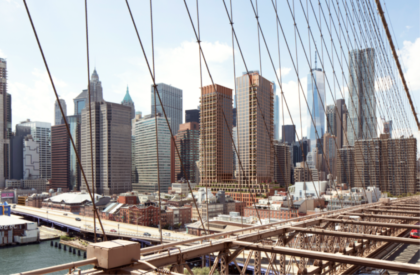
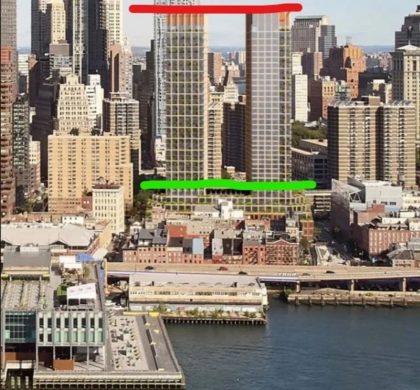
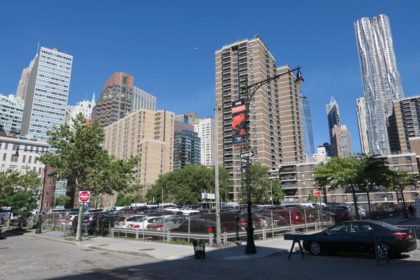
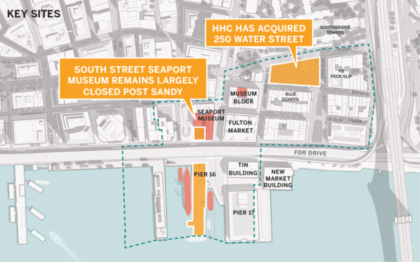
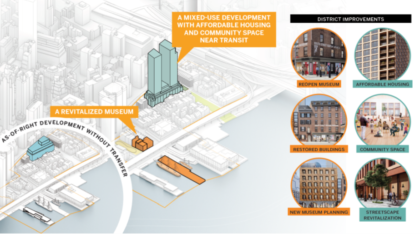
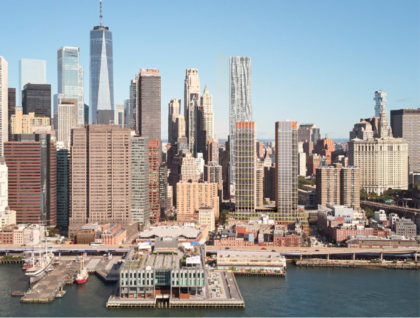





This is a confusing as the Landmarks Committee does not consider or review many of the “touted” benefits: nothing on what is put inside the building such as condos vs affordable units vs office spaces and does not review any enhancements to the play street, etc.. Even stranger, HHC said they are not using their option to buy the lot for the Museum’s New Building and the museum cannot afford it so there is no guarantee that part is going anywhere.
Please build it. Very consistent with the neighborhood of high rises. For example, the Gehry building is literally a block and twice this height. Forcing the developers to cut the height would require them to cut affordable housing. Nevertheless, I am sure the alt-right NIMBYs will be out in full force fighting to protect parking lots for their luxury automobiles and against low income families.
water street is a pretty clear divider of this historic district. theres really not a reason to build towers that high except to benefit hhc. why couldnt hhc build a smaller tower with the same amount of affordable housing? you kind of sound like a plant for the developer
Considering the world as it is now, this project is ridiculous. In the 50 years I’ve lived in the area, the seaport has been revised numerous times, unfortunately without much success. We survived the movement created by 9/11. Businesses and residents fleeing the area. Offices turned into residential spaces. Schools finally popping up, both public and private telling us there were many children residing in the area. The additional traffic on Pearl Street, entering and exiting the Brooklyn Bridge would be unbearable. HHC already has failed with the seaport. Businesses already leaving. Nothing contributed to the neighborhood at all, besides ridiculously expensive shops and restaurants that locals don’t use. In my lifetime, I would appreciate seeing CB1 and the Landmarks Comission say NO and do something for the good of the neighborhood.